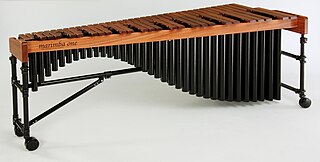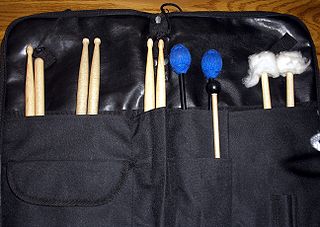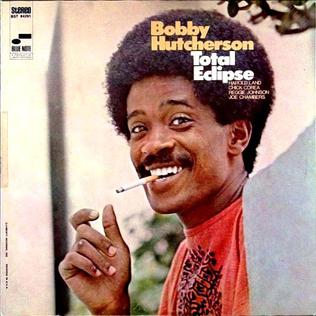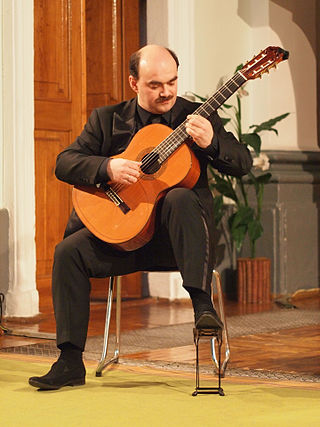
The marimba is a musical instrument in the percussion family that consists of wooden bars that are struck by mallets. Below each bar is a resonator pipe that amplifies particular harmonics of its sound. Compared to the xylophone, the timbre of the marimba is warmer, deeper, more resonant, and more pure. It also tends to have a lower range than that of a xylophone. Typically, the bars of a marimba are arranged chromatically, like the keys of a piano. The marimba is a type of idiophone.

The vibraphone is a percussion instrument in the metallophone family. It consists of tuned metal bars and is typically played by using mallets to strike the bars. A person who plays the vibraphone is called a vibraphonist,vibraharpist, or vibist.
Lead guitar is a musical part for a guitar in which the guitarist plays melody lines, instrumental fill passages, guitar solos, and occasionally, some riffs and chords within a song structure. The lead is the featured guitar, which usually plays single-note-based lines or double-stops. In rock, heavy metal, blues, jazz, punk, fusion, some pop, and other music styles, lead guitar lines are usually supported by a second guitarist who plays rhythm guitar, which consists of accompaniment chords and riffs.

A percussion mallet or beater is an object used to strike or beat a percussion instrument in order to produce its sound.

Gary Burton is an American jazz vibraphonist, composer, and educator. Burton developed a pianistic style of four-mallet technique as an alternative to the prevailing two-mallet technique. This approach caused him to be heralded as an innovator, and his sound and technique are widely imitated. He is also known for pioneering fusion jazz and popularizing the duet format in jazz, as well as being a major figure in music education from his 30 years teaching at the Berklee College of Music.

Fingerstyle guitar is the technique of playing the guitar or bass guitar by plucking the strings directly with the fingertips, fingernails, or picks attached to fingers, as opposed to flatpicking. The term "fingerstyle" is something of a misnomer, since it is present in several different genres and styles of music—but mostly, because it involves a completely different technique, not just a "style" of playing, especially for the guitarist's picking/plucking hand. The term is often used synonymously with fingerpicking except in classical guitar circles, although fingerpicking can also refer to a specific tradition of folk, blues and country guitar playing in the US. The terms "fingerstyle" and "fingerpicking" also applied to similar string instruments such as the banjo.
Stevens grip is a technique for playing keyboard percussion instruments with four mallets developed by Leigh Howard Stevens. While marimba performance with two, four, and even six mallets had been done for more than a century, Stevens developed this grip based on the Musser grip, looking to expanded musical possibilities. Stevens codified his grip and his approach to performance techniques developed during his studies at the Eastman School of Music in his 1979 book, Method of Movement for Marimba. In this book, Stevens explains that his grip is an evolution of the Musser grip, and it is sometimes called the Musser-Stevens grip.

Total Eclipse is an album by jazz vibraphonist Bobby Hutcherson, released on the Blue Note label in 1969. It features Hutcherson's first recordings with saxophonist Harold Land, who would become a regular collaborator with Hutcherson throughout the early 1970s. Four of the five tracks are Hutcherson compositions, the exception being Chick Corea's "Matrix".

In classical guitar, the right hand is developed in such a way that it can sustain two, three, and four voice harmonies while also paying special attention to tone production. The index (i), middle (m), and ring (a) fingers are generally used to play the melody, while the thumb (p) accompanies in the bass register adding harmony and produces a comparable texture and effect to that of the piano. The classical guitar is a solo polyphonic instrument, and it is difficult to master.

The khong wong yai is a circle with gongs used in the music of Thailand. It has 16 tuned bossed gongs in a rattan frame and is played with two beaters. The player sits in the center of the circle. It is used in the piphat ensemble to provide the skeletal melody the other instruments of the elaborate ensemble. The gongs are individually tuned with beeswax under the gongs. The khong wong yai can either be played with soft beaters or hard beaters.
Damping is a technique in music for altering the sound of a musical instrument by reducing oscillations or vibrations. Damping methods are used for a number of instruments.

Who Is Gary Burton? is an album by vibraphonist Gary Burton recorded in 1962 and released on the RCA label. Some of the musicians who appear are alto saxophonist Phil Woods, trombonist Bob Brookmeyer, trumpeter Clark Terry, pianist Tommy Flanagan, bassist John Neves and drummer Joe Morello.

The Groovy Sound of Music is an album by vibraphonist Gary Burton recorded in 1964 and released on the RCA label which features jazz interpretations of tunes from the Broadway musical The Sound of Music written by Richard Rodgers and Oscar Hammerstein II.

Alone at Last is the first solo album by vibraphonist Gary Burton, on which he also plays piano and organ. It was recorded in 1971, and features three performances from the Montreux Jazz Festival and four performances from the studio. It released on the Atlantic label in 1972. The album was awarded a Grammy for Best Jazz Performance by a Soloist at the 15th Grammy Awards.

In percussion, grip refers to the manner in which the player holds the percussion mallet or mallets, whether drum sticks or other mallets.

Two by Four, released in 1989 by the EmArcy label, is a collection of duets by jazz acoustic bassist Marc Johnson. His duet partners include vibraphonist Gary Burton and harmonica virtuoso Toots Thielemans.
The Fulcrum grip is a four-mallet grip for vibraphone and marimba developed by vibraphonist and educator Ed Saindon. The aim of the grip is to use varying fulcrum positions and finger technique to achieve the control, speed, and power of a two-mallet grip while being able to use all four mallets.

Guided Tour is a studio album by American jazz vibraphonist Gary Burton. The album was recorded in New York City together with guitarist Julian Lage, bassist Scott Colley and drummer Antonio Sanchez, and released on August 6, 2013 via Mack Avenue Records. The record consists of 10 tracks, paying tribute to the legacies of Thelonious Monk, Bill Evans, Jim Hall, and Astor Piazzolla. Eight of the compositions were by band-members. This was Burton’s final studio album before his 2017 retirement.

Generations is a studio album by American jazz vibraphonist Gary Burton. The album was released on April 13, 2004 via Concord Jazz label. It features Burton with a younger band of guitarist Julian Lage, pianist Makoto Ozone, bassist James Genus and drummer Clarence Penn.

Right Time, Right Place is a duo album by American jazz vibraphonist Gary Burton and Canadian pianist Paul Bley. The album was recorded in Denmark and released in 1990 via GNP Crescendo label.
















